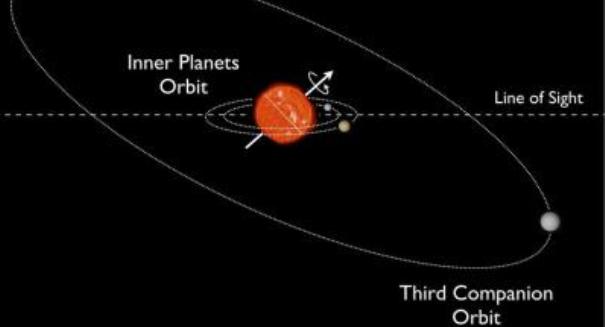
A planet orbit that tilts away from other planets or from the host star's equator implies that the planet had a difficult youth.
A team of astronomers has found a strange “tilted” planetary system, according to a statement from Iowa State University. The distant planetary system holds several planets orbiting at a severe tilt to their host star. The finding was made using data obtained by NASA’s Kepler space telescope.
According to NBC News, the now-defunct Kepler space telescope has plenty of data left for astronomers to examine. The purpose of the Kepler Mission was to investigate the structure and diversity of planetary systems.
This discovery is unusual in that prior to this finding, such tilted orbits had been found in planetary systems with a “hot Jupiter” — an extrasolar planet whose features are similar to Jupiter, but which has extremely high surface temperatures because it circles very close to its parent star. This is the first time that such tilted orbits had been observed in multiplanetary systems without a hot Jupiter.
“This is a new level of detail about the architecture of a planetary system outside our solar system,” said co-author Steve Kawaler, an Iowa State University professor of physics and astronomy. “These studies allow us to draw a detailed picture of a distant system that provides a new and critical test of our understanding of how these very alien solar systems are structured.”
A team of researchers studied regular changes in the brightness of the host star, Kepler-56, a red giant star with two planets in nearby orbits and a massive third planet in a remote orbit. By calculating those oscillation frequencies and using spectroscopy data about the star’s temperature and chemistry, astronomers figured out the star’s diameter, as well as several other features.
Another team of researchers used analysis of the changes in brightness to help calculate the tilt of the rotation axis of Kepler-56. The team determined that the axis is tilted 45 degrees to the line of sight from Earth.
The most manageable way for a planetary system to develop is with the orbits in the same plane as the host star’s equator. That typically reveals that the planets formed from a thin disk of gas and dust encompassing the host star.
A planet orbit that tilts away from other planets or from the host star’s equator implies that the planet had a difficult youth. It may have been pulled into a different plane after encountering another planet or planets. Hot Jupiters, for example, alter their orbits after encountering other planets and materials, and thus have a much greater chance of tilted orbits.
In Kepler-56’s situation, the more massive outer planet seems to be perpetuating the tilted orbits of the two inner planets, by “pulling them into their inclined orbits,” according to Kawaler.
The results are published in the journal Science.
Leave a Reply